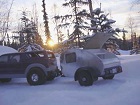Hi,
I am in the midst of my first canned ham renovation. It is an old Aljo, I believe from 1950. I'm very torn on my insulation and vapor barrier options and I would appreciate any advice. Some considerations, I live in Olympia, WA and it is a pretty consistently wet environment. I will be using the trailer year round as a studio. Likely heated in the winter but just open air in the summer. I also prefer not to use foam or fiberglass insulation. The framing is 2 inches deep.
I guess my primary concern is the wetness in this region and having enough insulation for winter without ending up with walls full of dampness and mold. I typically see people recommend a breathable outer layer like tyvec, but in a moist climate will this just invite trouble into my walls? I am considering the following combination, aluminum skin, tyvec, double bubble foil insulation, denim insulation, interior panel. Does this sound reasonable? Any other suggestions?
Thanks!!
Gabriel
canned ham insulation for wet region??
4 posts
• Page 1 of 1
Re: canned ham insulation for wet region??
- Gabriel, Tyvec is an exterior barrier. It's meant to allow the wall to breath outward & keep rain out during home construction. After the lap siding is applied it would also keep windblown rain from entering the walls. However, on a trailer, once you attach the aluminum & seal the corners ect. the skin becomes the outer barrier. The Tyvec isn't needed. Bubble foil has a very low R-value. Denim insulation absorbs moisture if it has no interior vapor barrier. Without an interior barrier the moisture created by breathing, cooking, bathing & heating will migrate into the walls, ceiling & floor. That moisture trapped by the aluminum will degrade the value of the insulation & set up the opportunity for mold & wood rot.
- I'd recommend two inches of extruded polystyrene fit tightly in the voids because it does not absorb moisture. To complete the interior vapor barrier use vapor barrier tape to seal the framing, window/door openings & any other places where moisture can pass into the walls, ceiling & floor.
- Here is an example:
- Proper ventilation & air exchange, of course, is needed to reduce the amount of interior moisture.
- Welcome to the forum, Fred
Northern Lite Traveler design: viewtopic.php?f=27&t=51991
Minimalist torsion axle frame: viewtopic.php?f=35&t=12220
Alaska Teardrop photo gallery: http://tnttt.com/gallery/album.php?album_id=2014
Glampette photo gallery; gallery/album.php?album_id=2983&sk=t&sd=d&st=0
Minimalist torsion axle frame: viewtopic.php?f=35&t=12220
Alaska Teardrop photo gallery: http://tnttt.com/gallery/album.php?album_id=2014
Glampette photo gallery; gallery/album.php?album_id=2983&sk=t&sd=d&st=0
-

alaska teardrop - Platinum Donating Member
- Posts: 1112
- Images: 177
- Joined: Wed Aug 24, 2005 1:41 pm
- Location: Greenville, Michigan

